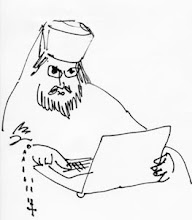The Church is represented in the Holy Mysteries, not in figure only, but as the limbs are represented in the heart, and the branches in the root, and, as our Lord has said, the shoots in the vine. For here is no mere sharing of a name, or analogy by resemblance, but an identity of actuality.Notice Cabsilas' striking insistence that the Church and Christ are indeed one and the same. The Church is represented in the Eucharist "not in figure only," nor by "analogy of resemblance," but by an "identity of actuality." The Church is Christ's very Body.
For the Holy Mysteries are the Body and Blood of Christ, which are to the Church true food and drink. When she partakes of them, she does not transform them into the human body, as we do with ordinary food, but she is changed into them, for the higher and divine elements overcomes the earthly one. When iron is placed in the fire, it becomes fire; it does not, however, give the fire the propensities of iron; and just as when we see white-hot iron it seems to be fire and not metal, since all the characteristics of the iron have been destroyed by the action of the fire, so, if one could see the Church of Christ, insofar as she is united to Him and shares in His sacred Body, one would see nothing other than the Body of the Lord.
Because of this, St Paul wrote: "Ye are the body of Christ, and members in particular" [I Cor 12:27]. If he called Christ the head and us the members, it was not that He might express His loving care for us, His teaching and admonition, or our complete subjection to Him, as we, in exaggeration, sometimes describe ourselves as a member of our relatives or friends, but to demonstrate a fact – to wit, that from henceforth the faithful, through the blood of Christ, would live in Christ, truly dependent on that Head and clothed with that Body.
This is why it is not unreasonable to say that the Holy Mysteries represent the Church.
This real and concrete identity of Christ with the Church is realized in the Eucharist: when we, the Church, partake of Christ's Body and Blood, these Mysteries do not become us – as with regular food – but we become Him. One might even say that we do not partake of Christ in the Holy Mysteries; He partakes of us. There is no longer Church and Christ: there is only Christ.
When St Paul writes that Christ is the head and we the members, St Nicholas Cabasilas writes, it was not by "exaggeration," but "to demonstrate a fact." Christ is the heart of which we, the Church, are the limbs; Christ is the root of which we are the branches; Christ is the vine of which we are the shoots.
It is no mere image, metaphor, analogy, or figure of speech to assert that the Church is the Body of Christ, and that each one of us is a member of Christ and, consequently, of one another. It is for this reason that the Church can only be One. As St Irenaeus would say: One God, One Christ, One Eucharist. To say that the Church is One is not to exclude but to include: all who partake of the Eucharist become members of the One Christ, and thereby sons of the One God and vessels of the One Spirit. Exclusion takes place only by being living apart from the One Church, and thereby being separating oneself from both Christ and humanity.
We should remember, then, that partaking of Holy Communion is not a private act of devotion; by Communing we realize our unity with Christ and with all other members of the Church, both living and dead, in an identity of actuality.









No comments:
Post a Comment